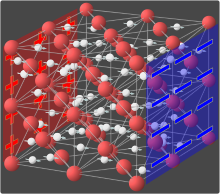Proton conductor

A proton conductor is an electrolyte, typically a solid electrolyte, in which H+[1] are the primary charge carriers.
Composition
[edit]Acid solutions exhibit proton-conductivity, while pure proton conductors are usually dry solids. Typical materials are polymers or ceramic. Typically, the pores in practical materials are small such that protons dominate direct current and transport of cations or bulk solvent is prevented. Water ice is a common example of a pure proton conductor, albeit a relatively poor one.[2] A special form of water ice, superionic water, has been shown to conduct much more efficiently than normal water ice.[3]
Solid-phase proton conduction was first suggested by Alfred Rene Jean Paul Ubbelohde and S. E. Rogers. in 1950,[4] although electrolyte proton currents have been recognized since 1806.
Proton conduction has also been observed in the new type of proton conductors for fuel cells – protic organic ionic plastic crystals (POIPCs), such as 1,2,4-triazolium perfluorobutanesulfonate[5] and imidazolium methanesulfonate.[6] In particular, a high ionic conductivity of 10 mS/cm is reached at 185 °C in the plastic phase of imidazolium methanesulfonate.
When in the form of thin membranes, proton conductors are an essential part of small, inexpensive fuel cells. The polymer nafion is a typical proton conductor in fuel cells. A jelly-like substance similar to Nafion residing in the ampullae of Lorenzini of sharks has proton conductivity only slightly lower than nafion.[7][8]
High proton conductivity has been reported among alkaline-earth cerates and zirconate based perovskite materials such as acceptor doped SrCeO3, BaCeO3 and BaZrO3.[9] Relatively high proton conductivity has also been found in rare-earth ortho-niobates and ortho-tantalates as well as rare-earth tungstates.[10]
References
[edit]- ^ Traditionally, but not precisely, H+ ions are referred as "protons".
- ^ Ramesh Suvvada (1996). "Lecture 12: Proton Conduction, Stoichiometry". University of Illinois at Urbana–Champaign. Retrieved 2009-12-06.
- ^ Sugimura, Emiko; Komabayashi, Tetsuya; Ohta, Kenji; Hirose, Kei; Ohishi, Yasuo; Dubrovinsky, Leonid S. (2012-11-21). "Experimental evidence of superionic conduction in H 2 O ice". The Journal of Chemical Physics. 137 (19): 194505. Bibcode:2012JChPh.137s4505S. doi:10.1063/1.4766816. hdl:20.500.11820/72f4ed9b-47ba-450d-9ba9-9ca5df9f21f7. ISSN 0021-9606. PMID 23181324. S2CID 44731086.
- ^ S. E. Rogers & A. R. Ubbelohde (1950). "Melting and Crystal Structure III: Low-melting Acid Sulphates". Transactions of the Faraday Society. 46: 1051–1061. doi:10.1039/tf9504601051.
- ^ Jiangshui Luo; Annemette H. Jensen; Neil R. Brooks; Jeroen Sniekers; Martin Knipper; David Aili; Qingfeng Li; Bram Vanroy; Michael Wübbenhorst; Feng Yan; Luc Van Meervelt; Zhigang Shao; Jianhua Fang; Zheng-Hong Luo; Dirk E. De Vos; Koen Binnemans; Jan Fransaer (2015). "1,2,4-Triazolium perfluorobutanesulfonate as an archetypal pure protic organic ionic plastic crystal electrolyte for all-solid-state fuel cells". Energy & Environmental Science. 8 (4): 1276. doi:10.1039/C4EE02280G.
- ^ Jiangshui Luo, Olaf Conrad & Ivo F. J. Vankelecom (2013). "Imidazolium methanesulfonate as a high temperature proton conductor". Journal of Materials Chemistry A. 1 (6): 2238. doi:10.1039/C2TA00713D.
- ^ Sarah Kaplan (2021-10-27) [2016-05-16]. "Sharks' electricity-sensing organs are even more powerful than we realized". The Washington Post. Washington, D.C. ISSN 0190-8286. OCLC 1330888409.[please check these dates]
- ^ Erik E. Josberger; Pegah Hassanzadeh; Yingxin Deng; Joel Sohn; Michael J. Rego; Chris T. Amemiya & Marco Rolandi (2016). "Proton conductivity in ampullae of Lorenzini jelly". Science Advances. 2 (5): 1–6. Bibcode:2016SciA....2E0112J. doi:10.1126/sciadv.1600112. PMC 4928922. PMID 27386543.
- ^ K. D. Kreuer (2003). "Proton-conducting oxides". Annual Review of Materials Research. 33: 333–359. Bibcode:2003AnRMS..33..333K. doi:10.1146/annurev.matsci.33.022802.091825.
- ^ Haugsrud, Reidar; Norby, Truls (1 March 2006). "Proton conduction in rare-earth ortho-niobates and ortho-tantalates". Nature Materials. 5 (3): 193–196. Bibcode:2006NatMa...5..193H. doi:10.1038/nmat1591.
